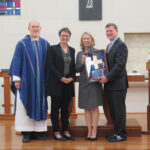By Barb Arland-Fye
Editor
A family friend e-mailed me excitedly about a play he had heard advertised on public radio. “It’s about autism,” he said. I clicked the link he sent. Tectonic Theater Project’s “Uncommon Sense” would be performed the following week.

I asked my husband Steve to accompany me to the performance at the University of Northern Iowa’s Gallagher Performing Arts Center. “Let’s take Colin,” I said, referring to our 29-year-old son with autism.
Uncommon Sense tells several stories simultaneously of individuals on the autism spectrum. “In telling these uncommon stories, we have employed all of the physical tools of the theatre to communicate the inner life of people on the spectrum, providing a sensory experience for both audience and characters alike,” the play’s authors note.
A sensory experience involving water at the play’s start bothered my husband. “Moose,” portrayed as a young adult with profound autism, appeared on the dimly lit stage naked, with his back to us. Someone on a platform above Moose slowly poured water from a watering can onto him; he reveled in it. The scene brought to my mind Colin’s temporary obsession with water long ago; he constantly turned on faucets, sprayed the kitchen and flushed the toilets.
Each character with autism demonstrated some characteristics similar to Colin’s, but no one was exactly like him. Two of the characters were unable to use their voices to speak meaningful language. One spent hours playing with water; the other poured handfuls of rice, over and over again. Two other characters could be described as high functioning, quirky individuals with autism. The performers played more than one character and deftly adapted to each role.
My heart ached throughout the play for the families and individuals living with autism. The background music heightened my desire to wrap each one in my arms. When the parents of Moose jumped up and down at hearing him utter a word, I could feel their elation. Even though my son is highly verbal, I knew the exhilarating experience of witnessing a hard-fought milestone. The parents’ apologetic attitude toward acquaintances and strangers reminded Steve and me of our younger selves as parents.
I cringed when the church lady bellowed at Moose’s parents about his terrible behavior in Sunday school and how he was no longer welcome there. We initially felt rejected as newcomers in our parish, but continued to attend Mass. As parishioners got to know our family, we warmed up to each other.
Scenes between Dan, a high-functioning man with autism, and his quirky love interest, Sarah, captivated me. Dan and Sarah miscommunicated at times, causing hurt feelings between them. Ultimately, both realized their love for each other and their need to be more aware of the way they communicated.
As the play concluded, Moose’s parents came to terms with placing him in a specialized program that could help him thrive. Another character with a brilliant mind but inadequate social skills was determined to transfer to a college better equipped to meet her needs. Still another character found her “voice” with an electronic device. Dan got a good job and he and Sarah were committed to each other. Colin told me afterwards that he thought the play was great. He really liked Dan and Sarah. But he still doesn’t understand autism; he’s too close to it.
“The play attempts to pull back the curtain on the external behaviors and sensory needs and language barriers that exist between the two worlds of autistic and non-autistic, to reveal the humanity (and the biology) and the connections we all share,” the authors observed. Mission accomplished.











